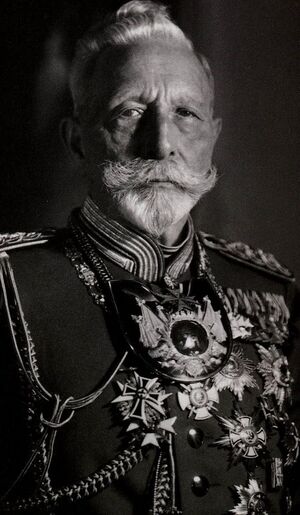Wilhelm III, Englean Emperor
This article is incomplete because it is pending further input from participants, or it is a work-in-progress by one author. Please comment on this article's talk page to share your input, comments and questions. Note: To contribute to this article, you may need to seek help from the author(s) of this page. |
| Wilhelm III der Große | |||||
|---|---|---|---|---|---|
 Wilhelm III, 1957 | |||||
| Englean Emperor | |||||
| Reign | 1905-1966 | ||||
| Coronation | May 25, 1905 | ||||
| Predecessor | Ferdinand I | ||||
| Successor | Konrad I | ||||
| King of Hohenzern | |||||
| Reign | 1905-1966 | ||||
| Coronation | May 25, 1905 | ||||
| Predecessor | Ferdinand I | ||||
| Successor | Konrad I | ||||
| Born | 16 July 1886 Potsdemspalais, Potsdem | ||||
| Died | 19 December, 1966 | ||||
| Burial | 23 February, 1967 | ||||
| Spouse | Alexandrine von Waldeck-Preusstadt | ||||
| Issue | |||||
| |||||
| House | Hohenzern | ||||
| Father | Friedrich Wilhelm II, Englean Emperor | ||||
| Mother | Auguste Louise von Fürstenberg | ||||
| Religion | Christianity (Englean Imperial Church) | ||||
Kaiser Wilhelm III (also known as Wilhelm der Große) (16 July, 1886 - 19 December, 1966) was the 26th Emperor of the Englean Kaiserreich and King of Hohenzern, reigning from 1905 to his death in 1966. Wilhelm III is often considered the "greatest Englean emperor of the modern age" due to his actions in the 20th century that brought the Englean Kaiserreich into the place of a World Great Power through victories the two Sunalayan Great Wars as well as influential policies within the homeland.
Succeeding his late brother Ferdinand I in 1905, the emperor proved himself to be a very competent young leader through the First Great War which succeeded in garnering the trust and respect of the Englean populace. Through the following decades, Wilhelm would continue to focus on his dream of placing the Kaiserreich in a "place in the sun" enjoyed by major world powers during the late 19th and early 20th century. With this, Wilhelm would promote economic and infrastructural plans that improved the Englean economy and promoted the rights of the Englean working class in order to combat the growing support of communism and socialism within the empire. At the same time, multiple military investments were put into place in order to advance the Englean military to the new standards created by the Reichswehr in 1926.
The greatest success of the emperor was his leadership of the empire through the Second Great War and achieving a major victory for the nation, which effectively gave the empire its "place in the sun" that he had so worked for. Because of this victory, many Engleans referred to the emperor as Wilhelm der Große and the "true bearer of the Victor's Crown." Wilhelm continues to enjoy a high regard well into the 21st Century as the "greatest Englean emperor of the modern age."